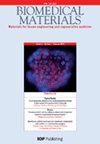Antiproliferative efficacy and mechanism of action of garlic phytochemicals-functionalized gold nanoparticles in triple-negative breast cancer cells
IF 3.7
3区 医学
Q2 ENGINEERING, BIOMEDICAL
引用次数: 0
Abstract
Fabrication of gold nanoparticles (GNPs) with phytochemicals is an emerging green nanotechnology approach with therapeutic implications. Garlic, known for its culinary and medicinal properties, has been extensively investigated for its anticancer properties. Here, we report a method to substantially enhance the antiproliferative potency of garlic by functionalizing its phytochemicals to GNPs and demonstrate a possible mechanism of action of these nanoparticles in the triple-negative breast cancer cell line, MDA-MB-231. Garlic gold nanoparticles (As-GNPs) were synthesized using garlic extract (As-EX) and gold chloride and characterized using a variety of spectroscopy techniques, and transmission electron microscopy (TEM). Compared to As-EX, which has a negligible effect on the viability of the cells, As-GNPs inhibited cell viability with an IC50 of 0.310 ± 0.04 mg ml−1 and strongly inhibited the clonogenic and migratory propensities of these cells. As indicated by TEM, the As-GNPs entered the cells via endocytosis and dispersed in the cellular milieu. Since tubulin, the protein involved in cell division, is a verified target for several antiproliferative drugs, we next examined whether the As-GNPs interact with this protein. The As-GNPs showed concentration-dependent binding to purified tubulin, slightly but consistently perturbing its secondary helical integritywithout grossly damaging the tertiary structure of the protein or the net polymer mass of the microtubules, as indicated by a tryptophan-quenching assay, far UV-circular dichroism spectroscopy, anilinonaphthalene sulfonate-binding assay, and polymer mass analysis, respectively. In cells, As-GNPs killed the cancer cells without cell cycle arrest, as evidenced by flow cytometry.大蒜植物化学物质功能化金纳米粒子在三阴性乳腺癌细胞中的抗增殖功效和作用机制
用植物化学物质制造金纳米粒子(GNPs)是一种具有治疗意义的新兴绿色纳米技术方法。大蒜因其烹饪和药用特性而闻名,其抗癌特性已被广泛研究。在此,我们报告了一种通过将大蒜的植物化学物质功能化到 GNPs 来大幅提高大蒜抗增殖效力的方法,并展示了这些纳米粒子在三阴性乳腺癌细胞系 MDA-MB-231 中的可能作用机制。研究人员使用大蒜提取物(As-EX)和氯化金合成了大蒜金纳米粒子(As-GNPs),并使用多种光谱技术和透射电子显微镜(TEM)对其进行了表征。与对细胞活力影响微乎其微的 As-EX 相比,As-GNPs 抑制细胞活力的 IC50 为 0.310 ± 0.04 mg ml-1,并能强烈抑制这些细胞的克隆和迁移倾向。正如 TEM 所示,As-GNPs 通过内吞作用进入细胞,并在细胞环境中分散。由于参与细胞分裂的微管蛋白是几种抗增殖药物的验证靶标,我们接下来研究了 As-GNPs 是否与这种蛋白相互作用。色氨酸淬灭试验、远紫外-圆二色光谱、苯胺萘磺酸盐结合试验和聚合物质量分析表明,As-GNPs 与纯化的微管蛋白的结合具有浓度依赖性,会轻微但持续地扰乱其二级螺旋的完整性,而不会严重破坏蛋白质的三级结构或微管的净聚合物质量。流式细胞仪显示,在细胞中,As-GNPs 能杀死癌细胞,而不会导致细胞周期停滞。
本文章由计算机程序翻译,如有差异,请以英文原文为准。
求助全文
约1分钟内获得全文
求助全文
来源期刊

Biomedical materials
工程技术-材料科学:生物材料
CiteScore
6.70
自引率
7.50%
发文量
294
审稿时长
3 months
期刊介绍:
The goal of the journal is to publish original research findings and critical reviews that contribute to our knowledge about the composition, properties, and performance of materials for all applications relevant to human healthcare.
Typical areas of interest include (but are not limited to):
-Synthesis/characterization of biomedical materials-
Nature-inspired synthesis/biomineralization of biomedical materials-
In vitro/in vivo performance of biomedical materials-
Biofabrication technologies/applications: 3D bioprinting, bioink development, bioassembly & biopatterning-
Microfluidic systems (including disease models): fabrication, testing & translational applications-
Tissue engineering/regenerative medicine-
Interaction of molecules/cells with materials-
Effects of biomaterials on stem cell behaviour-
Growth factors/genes/cells incorporated into biomedical materials-
Biophysical cues/biocompatibility pathways in biomedical materials performance-
Clinical applications of biomedical materials for cell therapies in disease (cancer etc)-
Nanomedicine, nanotoxicology and nanopathology-
Pharmacokinetic considerations in drug delivery systems-
Risks of contrast media in imaging systems-
Biosafety aspects of gene delivery agents-
Preclinical and clinical performance of implantable biomedical materials-
Translational and regulatory matters
 求助内容:
求助内容: 应助结果提醒方式:
应助结果提醒方式:


